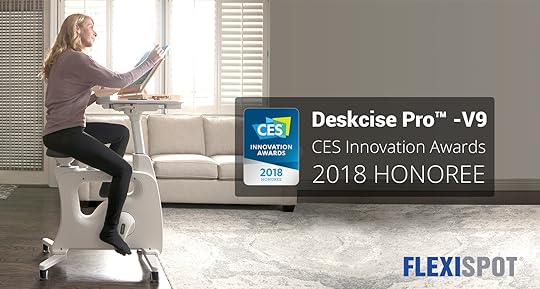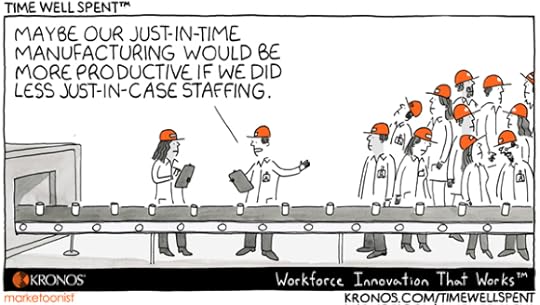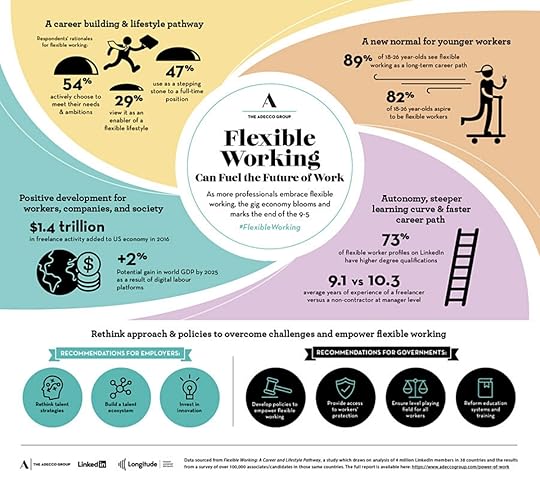Sharlyn J. Lauby's Blog, page 123
February 9, 2018
Bookmark This! Resources on Mindfulness and Stress Reduction
Workplace stress is an issue. According to The American Institute of Stress, 80 percent of workers feel stress on the job. Nearly half say that they need help in learning how to manage stress. An increasing number of organizations are looking at formal wellness programs, but honestly, that might not be enough. Organizations might have to think about how they create cultures that allow employees to feel comfortable practicing self-care.
This is by no means an exhaustive list, but a first step for human resources departments might be to understand what types of resources are available. I’ve put together a few from HR Bartender that you might find helpful.
Strategies for Handling Burnout – Happy hours can be fun, but they’re not an effective solution for workplace burnout. This article shares some resources that can help in handling burnout.
How to Reduce Individual Stress Levels at Work – Dr. Srikumar Rao, author of “Happiness at Work” outlines three activities to help reduce stress.
How to Create the Perfect Morning Routine – Whether it’s for productivity, wellness or other reasons, a good morning routine makes a difference. Here are 5 steps to help you get a good start each day.
There are Many Ways to Practice Mindfulness – Employee burnout has become a serious issue. What can we do about it? Mindfulness has surfaced as a possible solution. And there are many ways to do it.
The Business Benefits of Mindful Leadership – Mindfulness has become a topic of focus in boardrooms across the globe. Mindful leadership is about knowing how to treat others while accomplishing goals. Pandit Dasa gives a preview in this YouTube video.
Future Leaders Need Organizational Mindfulness – Organizational development expert Elad Levinson tells us that mindfulness is a necessary trait in leadership. It can be developed at every company level.
Everything Leaders Need to Know About Mindfulness – We are all challenged by “always being on”. Leaders and managers can’t afford the stress. Mindfulness can help clear the stress and promote focus.
One last resource that I wanted to share with you. If you like biographies and want a deeper dive into mindfulness, check out the book “Urban Monk: Exploring Karma, Consciousness, and the Divine”. It’s Pandit Dasa’s journey from growing up in India to becoming a monk in New York City. Absolutely fascinating and enlightening.
The ways that each of us manage stress are unique and personal. There are tools – like mindfulness – that can help us. And we have the ability to personalize the experience to meet our needs.
Oh, and P.S. If you want a visual reminder of the “5 Keys to Mindful Leadership”, Pandit sent me a something that you can put together and keep with you. I made a bookmark that I keep in my office planner. Simply print two copies of the “5 Keys”, trim it to the size you want, then laminate it. Make multiple copies and distribute them to the team.
The post Bookmark This! Resources on Mindfulness and Stress Reduction appeared first on hr bartender.






February 8, 2018
Employee Wellness: Give Your Employees Options
Mr. Bartender and I have been talking about our home offices lately. We haven’t updated our furniture in a while – well, except for my Herman Miller office chair – and we think we’re due. Lots of organizations are doing the same. They recognize the value in having a nice office space with good lighting, ergonomic furniture, etc.
But one of the things I’m realizing in the conversations Mr. B and I are having is that we both have different wants and needs when it comes to office space. Obviously, it’s based on the way we like to work. We’re a small company so it’s not a big deal. Large organizations have got to be experiencing the same challenge only on a larger scale. Whether you have two, ten, hundreds, or thousands of employees, not everyone will be equally productive using the same desk or chair.
This also applies to office exercise furniture. You know that, because I work from home, I have office exercise equipment like an under-desk elliptical and a treadmill desk. I’ve written about them before. It might be tempting to think all office exercise equipment is the same. Not true.
I really learned how different office exercise furniture is, and the need to have wellness options, when the good folks at FlexiSpot sent me a Deskcise Pro. It’s a combination standing desk and exercise bike and was selected as an at this year’s Consumer Electronics Show.
About the FlexiSpot Deskcise Pro
Let me start by telling you a little bit about the Deskcise Pro and how it works. The desk/bike is easy to assemble and needs no additional tools. It’s on wheels, so you can move it from office to office. The wheels have a gravity sensor, so the wheels won’t roll once someone sits on the bike seat. It also has non-slip pedals.
The Deskcise Pro is very adjustable. The desk surface can be close if you’re reading a book and further away if you’re working on a laptop. It has adjustable tension, depending on how much of a workout you’d like to get. And the seat height adjusts for a comfortable ride. While this video focuses on a home setting, it offers a nice overview of the bike’s features.
One thing the Deskcise Pro doesn’t have is an app. I asked FlexiSpot about this and they mentioned their technology team is currently in the process of designing one, but until then, you can use the LCD display on the bike which provides key performance statistics like mileage, calories burned, and time spent cycling. And of course, you can use your wellness wearable tracking systems (i.e. Fitbit, Apple Watch, etc.).
Not all Bikes are Created the Same
I know what you’re thinking. It’s a bike with a desktop on it. How hard can this be? Well, it’s harder than it looks. I use an under-desk elliptical every day and I’m finding this challenging. In a good way. Not all bikes are the same. They don’t use the same muscles, which is how I came to understand the importance of giving employees choices.
When I first started using the Deskcise Pro, I pedaled for 5-10 minutes a session and worked my way up in time. FlexiSpot doesn’t recommend using the bike for more than 45 minutes in a single workout. Over time, I realized that the bike made me very conscious of my posture and balance. Depending on the tension setting, it can get your heart rate up a little. But not so much that you break a sweat.
How Does a Standing Desk / Bike Fit Into the Work Environment
I’ve been using the Deskcise Pro for a month or so and I could see it complementing office spaces that already have treadmills, ellipticals, etc. Again, it’s not the same. Where I have challenges typing while walking on a treadmill, I’m able to easily type and take notes while using the Deskcise Pro. Great for listening to a webinar or meeting. Typing emails are no problem.
And with the wheels, employees could move it around the office space. You’re not really going to move a treadmill around. The Deskcise Pro can sit in a conference room one day and the employee break room the next. Mr. B and I really like that we can easily wheel it around to a place that works for each of us.
Give Employees Variety in Their Wellness Options
When it comes time to think about the work environment, many things matter. The desks, chairs, lights, etc. all matter. The technology employees use matters. Little things such as having coffee or tea available to employees…matters.
Wellness efforts, such as offering standing desk / bikes, allow employees to work and be productive at the same. If things are stressful, it can provide employees a place to cycle for 15-20 minutes with some headphones on and decompress. And at a price point of less than $500, organizations large and small can show employees they care about everyone’s wellbeing.
P.S. If you’re interested in learning more about the FlexiSpot Deskcise Pro, You can also check out their website. Quantity discounts are available.
The post Employee Wellness: Give Your Employees Options appeared first on hr bartender.






February 6, 2018
How to Evaluate the Effectiveness of Your Recruiting Sources
A few months ago, I had the opportunity to hear Shally Steckerl, founder of The Sourcing Institute Foundation and senior sourcing consultant at Fiserv, talk about “Using Tools and Pipelines to Source Talent” at the Recruiting Trends & Talent Tech Conference. One of the things he mentioned stuck with me: the notion that it’s not only important to find and try new recruiting sources, but to evaluate their effectiveness.
It reminded me of a panel discussion led by Tim Sackett, president at HRU Technical Resources, during last year’s TATech Spring Congress. He asked panelists how long they gave a new source to prove itself. Most panelist were comfortable saying a year. I must admit I was surprised. In my career, when I wanted to try new recruiting sources, senior management was looking for immediate return on the investment. Instant gratification if you will. A year would have been a luxury.
Back to evaluating your recruiting sources. It got me thinking. What steps should someone take when they’re considering the effectiveness of a recruiting source.
First, decide what effectiveness means. This isn’t as easy as it sounds. Does being an effective source mean lots of applications? Or a lot of interviews? Or a lot of hires? Maybe it means not only quantity of hires, but quality after the introductory period has ended? Does it include cost-per-hire? I can’t tell you what effectiveness means for your organization, but I can say that it’s important for recruiters to decide…and be consistent.
Get management to buy-in. Maybe it’s because I’ve been in this situation one too many times, but recruiters will want to make sure that hiring managers are on the same page when it comes to the effectiveness of sources. If managers think a great source is one that supplies piles of applicant flow and HR thinks it’s about quality over quantity, there it could be a challenge getting buy-in for a particular source.
Agree on time frames, data collection, and reporting. I mentioned earlier that I’ve worked places where sources just got one try. I know that’s not fair, but that was what senior management was willing to finance. It’s equally important to make sure that everyone will accept the data regarding sources. The good news is that many recruiting technology solutions can supply this data, so there shouldn’t be too many questions about its validity.
Determine the consequences. Okay, so you’re measuring the effectiveness of sources. That’s great. What happens if a source isn’t cutting it? It makes no sense to track effectiveness if nothing is going to happen to ineffective sources. This is going to put some pressure on recruiters, because sometimes doing something…anything…is better than nothing. Even if it is a less than reliable source.
Let source providers know. If the company is using third-party sources like job boards, career fairs, search firms, etc. for their recruiting, it’s only fair to tell these providers that if they aren’t effective, the company will have to reevaluate the partnership. That’s not a mean thing to do. In fact, it could make some sense to share the metrics with your third-party sources. Maybe they have some ideas to improve effectiveness using their product or service.
Talent is a key differentiator for businesses. Finding excellent recruiting sources translates into finding the best talent. But, recruiters need to constantly evaluate sources to ensure they remain competitive. Because when recruiting is competitive, the organization is competitive.
Image captured by Sharlyn Lauby after speaking at the Learning and Development League 2016 Annual Conference in Delhi, India
The post How to Evaluate the Effectiveness of Your Recruiting Sources appeared first on hr bartender.






February 4, 2018
Feedback: 4 Ways to Avoid Employee Survey Fatigue
I’m a big believer that if you want to know what employees are thinking, you should ask them. And in this technology age, one of the best ways to do that is via an electronic survey.
Surveys are only as good as their design. It’s important when designing any type of survey that the questions are constructed properly and the number of questions makes sense. People are willing to take longer surveys for complex topics. You might even be able to do a series of surveys. For example, if you wanted to survey employees about health care, instead of one long survey, you could do a series of smaller ones on medical, dental, and prescription coverage.
However, too much of a good thing can backfire. Too many surveys can have the opposite effect. Or surveys that are too long can cause employees to abandon them mid-survey. There’s a fine line that needs to be maintained. When your organization utilizes surveys, here are four things to consider so employees don’t get survey fatigue.
Tell employees why surveys are important. This can be a conversation during orientation. Let employees know that you’re going to ask for their feedback. Tell them why an employee survey is valuable. Maybe even share an example or two of how employee survey feedback has improved the workplace.
Create an editorial calendar for your employee survey. It doesn’t need to be elaborate, but somewhere keep a calendar of the surveys that are scheduled to go out. Also make note of big events happening around the office like holidays, employee recognition parties, etc. That will keep you from scheduling surveys during peak busy times for the operation.
Sometimes say “no”. If there are too many requests for surveys during the same time, you might need to say “no”. Or schedule a survey that is less time sensitive. Or combine surveys. Be flexible and try to create a win-win. But also realize that overwhelming employees with surveys can impact the quality of data.
Share the results. Speaking of data, anytime you ask employees for their feedback, they need to see the results. They will be curious. Employees want to know if their thoughts were the same as others or if they’re not in sync with the majority. So always share survey results with the group.
An employee survey is an important part of how organizations get feedback. That’s a good thing. But surveys need to be constructed properly, implemented strategically, and communicated well. Because the last thing an organization wants is for their employees to come down with a case of survey fatigue.
Image captured by Sharlyn Lauby while in the Wynwood Art District in Miami, FL
The post Feedback: 4 Ways to Avoid Employee Survey Fatigue appeared first on hr bartender.






February 2, 2018
Staffing and Scheduling Are Two Different Things – Friday Distraction
Years ago, I worked on a consulting project for a company that was facing customer service challenges. They were convinced the problem was training. So, they brought in a group of consultants to help them determine their training needs.
Ends up, their challenge wasn’t training. At least not entirely. The issue was staffing and scheduling.
That’s why I wanted to share with you this Time Well Spent from our friends at Kronos. Yes, it’s important to be staffing right with the best talent. And it’s important to train employees. But all of that goes out the window if you don’t schedule employees at the right times.
Use operational planning tools to understand peak and slow times. Every business has busy and slow times. Understanding the operation will keep departments from over- and under- scheduling. Not only will it help the business run smoothly, but it keeps managers from sending employees home (or calling them in) when needed.
Talk with employees about their scheduling preferences. Not all employees want to work Monday through Friday from 9a to 5p. And not all employees want holidays off. Managers should take the time to get to know their employees and when they like to work.
Use technology to facilitate shift trades and last-minute coverage. Today’s workforce management technology solutions allow employees to handle their own shift trades and find someone to cover a shift in an emergency. Think of scheduling as a partnership.
Encourage cross-training. If you’re business runs into a lot of “last-minute” requests, consider cross-training employees. Instead of calling someone in to handle a last-minute thing, organizations can ask someone to stay an extra hour or reprioritize their workload.
Nobody wants bad scheduling – – not organizations or employees or customers! Companies don’t want the lost productivity. Employees don’t want to be bored (or overworked). And customers don’t want a frustrating experience. Look for ways to perfect scheduling using operational and technology tools. It’s a win for everyone!
The post Staffing and Scheduling Are Two Different Things – Friday Distraction appeared first on hr bartender.






February 1, 2018
How to Plan Time For Self Learning
I came across this article from Harvard Business Review titled, “6 Ways to Take Control of Your Career Development If Your Company Doesn’t Care About It”. I’d recommend bookmarking it and carving out time to read it.
But that’s also the challenge. There are lots of great articles about how to “own your career” or “the best leadership books to read”. I’m not knocking those articles. Heck, I’ve written a few of them. The question is time.
Managers and employees today have extremely full plates. They are being asked to do a lot at work. Maybe because the company is having challenges finding talent. They also have full lives at home with family and friends. So, where does self learning fit in? Here are a few ways to find time in your already busy schedule.
Be realistic about how much learning you can accomplish. First things first, prioritize your learning list. The goal is to make self learning a habit. The way we create habits is by starting small, developing a regular routine, and then adding to it. So, focus on one goal.
Build it into your morning routine. One of the great things about adding self learning to your morning routine is that you do it first thing in the morning. You can’t get talked out of it during the day. Or skip it because you’re tired after work. So, if you’re concerned about procrastination, think about learning first thing in the morning.
Take some time during your commute. Speaking of morning routine, if you have a drive or ride into work or school, consider listening to a short podcast as your self learning. You could also do this on the way home. I’m not suggesting giving up entertainment. So, in between listening to S-Town and Slow Burn, rotate in a couple of career development podcasts.
Schedule it on your calendar. When I put something on my calendar, it gets done. For example, I’m facilitating a virtual seminar for the Society for Human Resource Management (SHRM). The platform I’ll be working on is Adobe Connect. I have scheduled some time to watch videos on Adobe Connect. Block off time for learning.
Create an evening routine that includes learning. I’ve always been a fan of morning routines and as time goes on, I’m becoming a big fan of evening ones as well. Especially when it comes to reading. I can have a nice cuppa tea and read one chapter. That’s it…one chapter a night. Before you know it, I’ve finished a book.
Make it a group activity. There’s no rule that says you have to do this alone. Designate time each day or week as self learning time. Everyone in the family gets an hour to go off and learn something. Maybe everyone can talk about what they learned afterward. You could do the same thing in your department at work. Or just with a group of friends. (Laurie Ruettimann has started an HR Book Club. Check it out.)
Ask your boss for 1 hour. Next time you have a one-on-one meeting with your boss, ask them if you can have one hour a week (or month) to focus on your own learning. Your boss might ask what you want to do with the time, so be prepared to answer. But there’s no harm in asking for a small amount of time. In fact, it demonstrates initiative.
While none of these are a substitute for classroom training or a professional conference, they do allow people to learn on a gradual basis. And that’s a good thing. And, if you’re like me, you have a long list of things you’d like to learn, the challenge is finding the time. Think about those small topics you’d like to focus on and start building them into your daily routine. That’s how they get done!
Image captured by Sharlyn Lauby while wandering around Boston Logan Airport after a Workforce Institute board meeting
The post How to Plan Time For Self Learning appeared first on hr bartender.






January 30, 2018
The Future of HR: 10 Strategies for Every Human Resources Team
I ran across an INC article titled “What Does the Future of Human Resources Look Like?” I thought it was an interesting read, in particular the last paragraph where the author talks about job title changes. Their takeaway is that moving from job titles like chief human resources officer to chief experience officer signal a change in the profession.
I’m not sure that I agree with that. The candidate experience and employee experience have always been a part of HR. Maybe we didn’t call it the same thing. Or give it the same priority. But it’s been there.
I do believe though, articles like the INC one should prompt HR departments to have dedicated, intentional conversations about their function. Not simply what policies and programs do we want to implement in the year ahead, but where do we see ourselves going and is our work supporting it. To offer some perspective, here are a few of the most popular posts from HR Bartender that relate to the human resources function.
HR is Moving from People Science to Data Science
HR has always been about people. But today, HR is moving from people science to data science – about people. It’s an important shift for business and HR.
Human Resources Adding Value to the Company
The value in human resources is in guiding and enabling employees and their managers. The challenge is doing it an ever-changing business environment.
HR’s Role in Helping Organizations Accept Feedback
A feedback culture helps organizations and individuals do their best work. But the input needs quality and consistency. HR impacts feedback in five key ways.
The Right Way to Maintain Employee Files
There will always be a compliance side to HR. Employee files contain critical and sensitive information. For that reason, they need to be maintained properly.
4 Ways to Measure the Success of Your HR Programs
There is only one sure way to know if your HR programs are a success – measure the results. There may be many was to do that. Here is a proven method.
The 3 Key Metrics in HR Predictive Analytics
An increasing number of HR departments are designing analytical roles. Knowing these three-key metrics in HR predictive analytics may be useful.
If human resources departments want to evolve, they need to look at their own individual competencies. We talk a lot about department mangers making an investment in people. HR departments need to invest in themselves. Here are a few places to start:
7 Types of Power in the Workplace
There are 7 types of power in the workplace. We all have power. Learn the types of power to effectively use them in the workplace.
HR Competencies: Turning Knowledge into Action
We know the importance of competencies in our careers. SHRM does too. They’ve published a free ebook on how to bring the SHRM Competency Model to life.
The Only 3 Reasons to Hold a Business Meeting
One of the best skills professionals can develop is the ability to run a good business meeting. There are only three reasons to hold a business meeting.
SHRM Certification: Why Should HR Pros Pay Attention
The SHRM Certification is based on the competency model for human resources pros. Alex Alonso from SHRM explains the value of SHRM Certification.
I’ve said it before and I’ll say it again. It’s an exciting time to be in human resources. We have a tremendous opportunity to bring real and positive workplace change. It won’t be easy, but it starts with having a clear vision of our role in the organization. Then developing strategies to support it.
Image captured by Sharlyn Lauby while exploring the Neon Graveyard in Las Vegas, NV
The post The Future of HR: 10 Strategies for Every Human Resources Team appeared first on hr bartender.






January 28, 2018
Why Do Employees Leave An Organization in 2018 [POLL]
I came across an article from Harvard Business Review titled “Why People Really Quit Their Jobs”. It’s an interesting read worth checking out. It reminded me of a Glassdoor survey I saw recently that said voluntary quits are at an all-time high.
We’ve been talking about the shift to a candidate-driven market for quite some time. That’s not a surprise. What does surprise me are the reasons employees are leaving. On one hand, we have organizations reciting the old mantra “People don’t leave jobs; they leave bad managers.” And then, I read this Society for Human Resource Management (SHRM) article that says the majority of people leave for money.
I don’t have to tell you that those aren’t the same thing. So, which one is it? We haven’t done a poll in a while. I thought this might be a good question to ask.
/*
Main Container
---------------------------------------------------------------------------
*/
#yop-poll-other-answer-1_yp5a6d9ea8017ba-other {
color:#000000;
}
.yop-poll-customfield-1_yp5a6d9ea8017ba {
color:#000000;
}
div#yop-poll-container-1_yp5a6d9ea8017ba {
background:#B70004;
box-sizing: border-box;
display: inline-block;
font-size: 14px;
color:white;
padding: 10px;
width: 400px;
zoom: 1;
}
/* A nice little reset */
div.yop-poll-container * {
}
form#yop-poll-form-1_yp5a6d9ea8017ba {
}
/*
Error message
..................................
*/
div#yop-poll-container-error-1_yp5a6d9ea8017ba {
font-size:.8em;
font-style:italic;
color:red;
text-transform:lowercase;
text-align:center;
}
/*
Success message
..................................
*/
div#yop-poll-container-success-1_yp5a6d9ea8017ba {
font-size:.8em;
font-style:italic;
color:green;
text-align:center;
}
/*
Poll Question
---------------------------------------------------------------------------
*/
div#yop-poll-questions-container-1_yp5a6d9ea8017ba { margin:.5em; }
div.yop-poll-question-container-1_yp5a6d9ea8017ba { margin: 0; }
div.yop-poll-question-1_yp5a6d9ea8017ba {
border: 0 none;
margin: 0 0 2em;
padding: .25em;
text-align: center;
font-size: 14px;
}
/*
Poll Options / Answers
---------------------------------------------------------------------------
*/
div.yop-poll-answers-1_yp5a6d9ea8017ba {}
div.yop-poll-answers-1_yp5a6d9ea8017ba ul {
list-style: none;
margin: 0;
padding: 0;
}
div.yop-poll-answers-1_yp5a6d9ea8017ba ul li.yop-poll-li-answer-1_yp5a6d9ea8017ba,
div.yop-poll-answers-1_yp5a6d9ea8017ba ul li.yop-poll-li-result-1_yp5a6d9ea8017ba {
list-style: none;
margin: 0;
padding: 0;
font-size: 14px;
line-height: 2em;
}
div.yop-poll-answers-1_yp5a6d9ea8017ba ul li.yop-poll-li-result-1_yp5a6d9ea8017ba {padding-bottom: 1em;}
/*
Label
..................................
*/
div.yop-poll-answers-1_yp5a6d9ea8017ba ul li.yop-poll-li-answer-1_yp5a6d9ea8017ba label {
margin:0px;
font-style:normal;
font-weight:normal;
font-size:14px;
float:none;
display:inline-block;
}
/* Actual text label of the answer */
div.yop-poll-answers-1_yp5a6d9ea8017ba ul li.yop-poll-li-answer-1_yp5a6d9ea8017ba label:nth-of-type(2) {
}
/*
Custom answer / Other
..................................
*/
div.yop-poll-answers-1_yp5a6d9ea8017ba ul li.yop-poll-li-answer-1_yp5a6d9ea8017ba label:nth-of-type(3) {
width: 100%;
overflow: hidden;
}
div#yop-poll-container-1_yp5a6d9ea8017ba li.yop-poll-li-answer-1_yp5a6d9ea8017ba label:nth-of-type(3) input[type="text"] {
width: 94%;
overflow: hidden;
}
/*
Custom checkbox and radio button style
---------------------------------------------------------------------------
*/
/*
Custom fields
---------------------------------------------------------------------------
*/
div.yop-poll-customs-1_yp5a6d9ea8017ba {
clear: both;
}
div.yop-poll-customs-1_yp5a6d9ea8017ba ul {
list-style: none;
margin: 0;
padding: 0;
overflow: hidden;
width: 100%;
}
div.yop-poll-customs-1_yp5a6d9ea8017ba ul li.yop-poll-li-custom-1_yp5a6d9ea8017ba {
display: block;
font-size:14px;
list-style: none;
}
div.yop-poll-customs-1_yp5a6d9ea8017ba ul li.yop-poll-li-custom-1_yp5a6d9ea8017ba label {
display: block;
}
div#yop-poll-container-1_yp5a6d9ea8017ba li.yop-poll-li-custom-1_yp5a6d9ea8017ba input[type="text"] {
width: 94%;
}
/*
Vote Button
---------------------------------------------------------------------------
*/
.yop-poll-footer { /*height: 4em;*/ }
.yop-poll-vote-centered-1_yp5a6d9ea8017ba { text-align:center; }
#yop-poll-vote-1_yp5a6d9ea8017ba div button {
cursor:pointer;
display: block;
font-size:14px;
margin: 0 auto;
}
#yop-poll-vote-1_yp5a6d9ea8017ba div button.yop_poll_vote_button {}
#yop-poll-vote-1_yp5a6d9ea8017ba div button.yop_poll_wordpress_vote_button { margin: 1em auto 0; }
#yop-poll-vote-1_yp5a6d9ea8017ba div button.yop_poll_anonymous_vote_button { margin: 1em auto 0; }
/*
Results
---------------------------------------------------------------------------
*/
li.yop-poll-results-1_yp5a6d9ea8017ba {
font-size: 12px;
font-style: italic;
font-weight: normal;
margin-left: 15px;
color: #38595E;
}
/*
Style for results that are displayed on columns
..................................
*/
li.yop-poll-li-answer-1_yp5a6d9ea8017ba {
float: left;
display: inline-block;
width: 100%;
padding: 1%;
margin: 1%;
}
#yop-poll-vote-1_yp5a6d9ea8017ba div#yop-poll-results-1_yp5a6d9ea8017ba {
float: right;
width: auto;
}
#yop-poll-vote-1_yp5a6d9ea8017ba div#yop-poll-results-1_yp5a6d9ea8017ba a {
color:#000;
text-decoration:underline;
font-size:12px;
}
#yop-poll-vote-1_yp5a6d9ea8017ba div#yop-poll-back-1_yp5a6d9ea8017ba a {
color:#000;
text-decoration:underline;
font-size:12px;
}
#yop-poll-vote-1_yp5a6d9ea8017ba div#yop-poll-archive-1_yp5a6d9ea8017ba a {
color:#000;
text-decoration:underline;
font-size:12px;
}
#yop-poll-vote-1_yp5a6d9ea8017ba div {
float:left;
width:100%;
}
/*
Result Bar
..................................
*/
.yop-poll-results-bar-1_yp5a6d9ea8017ba div { background:#555; width:90%;}
/*
---------------------------------------------------------------------------
EXTRAS
---------------------------------------------------------------------------
*/
/*
CAPTCHA
..................................
*/
#yop-poll-captcha-input-div-1_yp5a6d9ea8017ba { margin-top:5px; }
#yop-poll-captcha-helpers-div-1_yp5a6d9ea8017ba {
width:30px;
float:left;
margin-left:5px;
height:0px;
}
#yop-poll-captcha-helpers-div-1_yp5a6d9ea8017ba img { margin-bottom:2px; }
#yop-poll-captcha-image-div-1_yp5a6d9ea8017ba { margin-bottom:5px; }
#yop_poll_captcha_image_1_yp5a6d9ea8017ba { float:left; }
.yop-poll-clear-1_yp5a6d9ea8017ba { clear:both; }
.yop-poll-name-1_yp5a6d9ea8017ba { color:#38595E; font-size: 18px; }
.yop-poll-li-answer-1_yp5a6d9ea8017ba label img { max-width: 98%; }
.yop-poll-li-result-1_yp5a6d9ea8017ba label span img { max-width: 98%; }
.content { position :unset !important; }
div.yop-poll-container br,
div#yop-poll-container-1_yp5a6d9ea8017ba br { display: none; }
div#yop_poll_vote_options_div-1_yp5a6d9ea8017ba div:nth-last-of-type(1) { display: none; }#yop-poll-container-1_yp5a6d9ea8017ba img {
max-width: 400px;
} .yop-poll-forms-display{}
If you were to start looking for a new job today, what would be the number one reason to leave?
Want a more supportive manager.
Want better compensation and benefits.
Want increase opportunities for advancement.
Want to be close to home or flexible work schedule.
Want better training and development.
Some other reason.
vote
Since it’s only one question, I hope you’ll take a second to respond. It’s completely confidential. I’ll publish the results in a week or two.
Organizations say that engaging and retaining employees is a top priority. If that’s true, then understanding the reasons that employees may start looking is key.
Image captured by Sharlyn Lauby while exploring the streets of Key West, FL
The post Why Do Employees Leave An Organization in 2018 [POLL] appeared first on hr bartender.






January 26, 2018
HR Pros Need to Build Freelancer Networks [infographic] – Friday Distraction
Being a consultant or freelancer really wasn’t cool back when I became one. If you went to a professional association meeting and said you were a consultant, people immediately made the incorrect assumption that you were going to start a sales pitch. Sadly, it may have been because it happened all too often.
Thankfully, today’s consulting world is different. According to McKinsey, an estimated 162 million people in the United States and European Union are involved in some sort of flexible work. That’s approximately 20 – 30 percent of the working population. When that many people are consulting in a full-time or part-time capacity, human resources professionals have to take notice. Because it creates a separate and unique pool of talent.
This infographic from LinkedIn and The Adecco Group does a nice job of highlighting the positive aspects of flexible work. Freelancer activity has contributed over $1 trillion (and yes, that’s not a typo) to the economy. It’s provided work / life balance to those that crave it, and allowed older workers to stay in the workforce longer.
But when you have a moment take a look at some of the key findings in the accompanying report, “Flexible Working: A Career and Lifestyle Pathway”. I was surprised at some of the data, such as the education and experience level of contractors. I came away with a couple of takeaways.
Individuals looking to make freelancing part of their lifestyle need to figure out how to make investments into their work environment and professional development. While companies are fine with hiring someone who works out of their home, they do want to know that the person they’ve contracted with is keeping their skills current and has the ability to keep up with technology.
Organizations wanting to hire contractors or consultants should start being strategic about these relationships. Instead of waiting until it’s mission critical to find someone, HR professionals might want to build a network of contractors that they can get to know before they need to engage. That way, when the time comes, the company can make a call – or a couple of calls – and have the best talent for the work.
I’m sure you’re reading the same articles that I am about demand for talent exceeding supply. A freelancer and contractor are an excellent way for organizations to get individuals with skills and experience. And who knows, maybe if they see your awesome culture, benefits, and management team, they can be talked into a full-time job.
The post HR Pros Need to Build Freelancer Networks [infographic] – Friday Distraction appeared first on hr bartender.






January 25, 2018
6 Business Lessons Learned From an Escape Room
Mr. Bartender and I recently went on a vacation just before the holidays. It was wonderful and relaxing…but that’s not the purpose of today’s post. One of the activities we participated in was an escape room.
Escape rooms are a physical adventure game where players solve a series of puzzles and riddles using clues to complete the secret plot in the room. I’ve been wanting to do this for a while, so I signed us up. What a mistake! The activity was a complete mess. But during this cluster, I did step back and learn a few things about teamwork and problem-solving.
First of all, let me explain how this escape room was organized. There were about 6-7 teams of 10-12 people each. In this activity, we were competing against each team to solve the puzzle and exit the escape room first. While this set-up doesn’t always happen in escape rooms, it is something we see in organizations. Having multiple teams in a company is common. Having a dozen people on a team is not unusual. And sadly, sometimes those teams operate at cross-purposes or compete for budget dollars. Here were my takeaways.
Everyone needs to understand the goal. And be motivated to achieve it. I understand that this just is a game. But even in games, there’s a goal you’re trying to achieve. It was evident that some groups didn’t know what an escape room was, how it worked, and what they received for participating. Even if it’s simply bragging rights.
The group must have a leader. It might sound really fantastic to say that the group doesn’t need a leader, but I’d call bravo sierra on that one. Teams need someone to lead. Even if it’s to make sure that everyone has information or gets a voice. Which leads me to the next lesson…
Every team member must receive the same communication. As soon as we were able to start, everyone in our group grabbed a puzzle and dispersed. The leader didn’t stop them. So, each person was doing their own thing. Team members weren’t able to help each other because they didn’t have the same information.
Being organized can be a team asset. When it comes to problem-solving, being organized can be a tremendous advantage. I’ve already mentioned that our clues were scattered all over. Not having a sense of order put us behind the other groups because we couldn’t see how the puzzle clues fit together.
Teams need problem-solving capabilities. Not only to solve problems, but to identify red herrings. One of the clever aspects to this escape room was the placement of a false clue (aka red herring). It’s important for teams to realize that they will collect lots of information but not necessarily need all of it to solve the problem.
All group activities should receive a debrief. Even if it’s a short one. Another good component to this escape room was a debrief. You guys know I’m a fan of debriefs and there’s research to show it improves performance by up to 20 percent.
While we didn’t win the challenge, nor did we even come close, I was reminded that there’s more to teamwork than simply putting a bunch of people together. Teams need leadership, training, and a common goal.
I’d also add that this experience hasn’t soured me on the escape room concept. Hopefully, I can do another one in the near future. Maybe in Chicago at the Society for Human Resource Management (SHRM) Annual Conference?
Image captured by Sharlyn Lauby before Cirque du Soleil’s spectacular Kurios in Miami, FL
The post 6 Business Lessons Learned From an Escape Room appeared first on hr bartender.






Sharlyn J. Lauby's Blog
- Sharlyn J. Lauby's profile
- 10 followers













